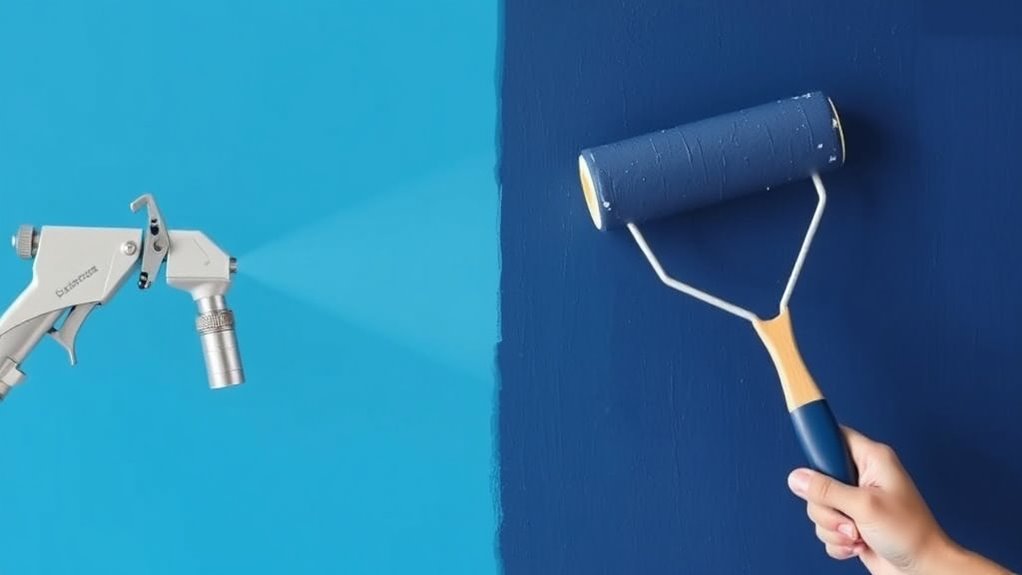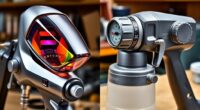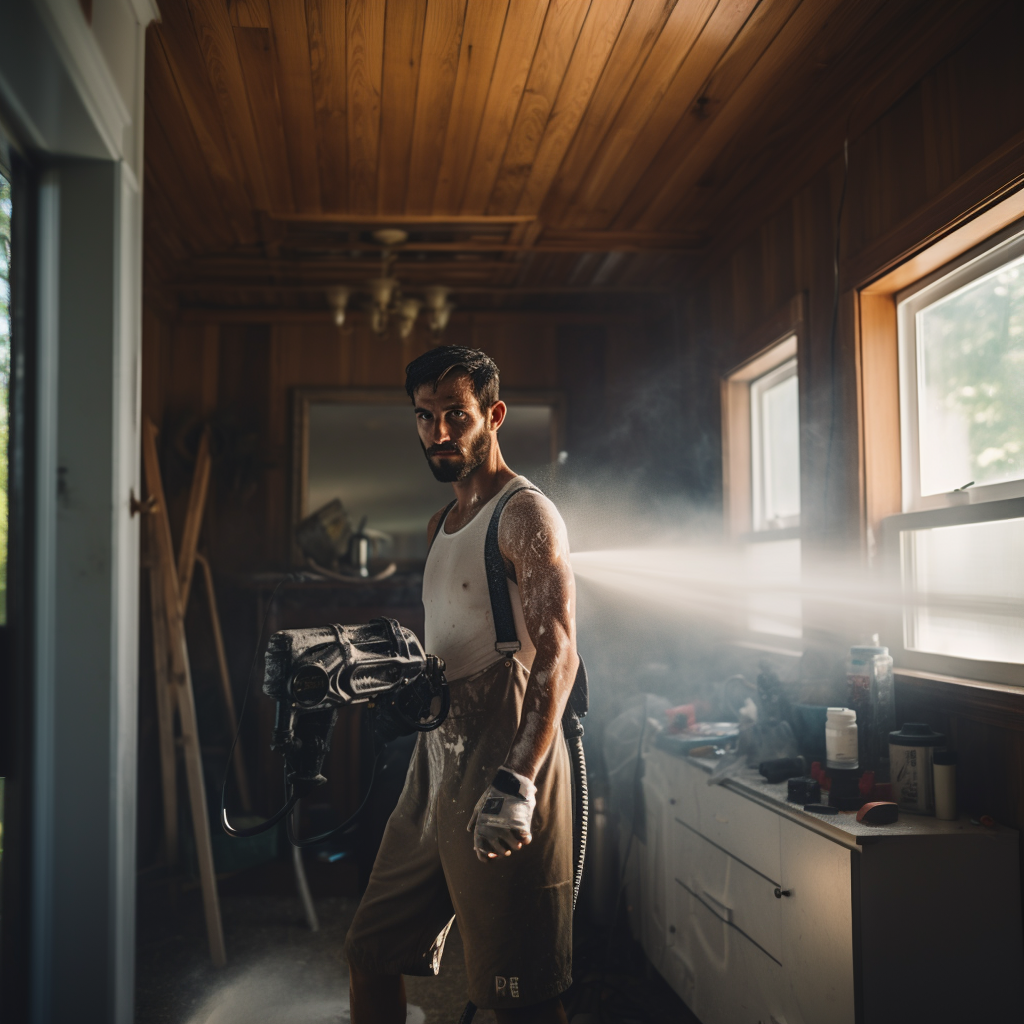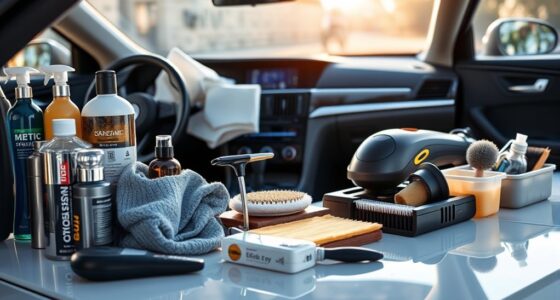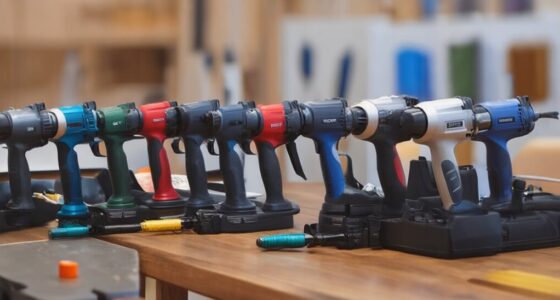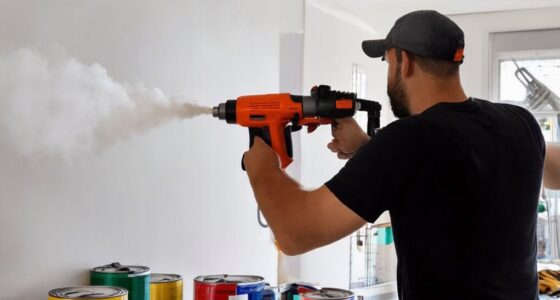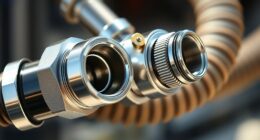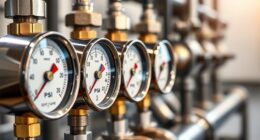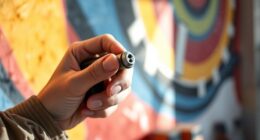Choosing between a paint sprayer and rollers or brushes depends on your project size, surface type, and desired finish. Sprayers work best for large, smooth surfaces, offering fast and even coverage, but require more setup and cleaning. Rollers and brushes are simpler, cheaper, and better for detailed or textured work. If you want quick results on big projects or detailed control, a sprayer might be your best choice. Keep exploring to find out which tool suits your needs perfectly.
Key Takeaways
- Sprayers offer faster, more uniform coverage ideal for large, smooth surfaces, while rollers and brushes are better for textured or detailed work.
- Manual tools are more budget-friendly and easier to learn, making them suitable for small projects or quick jobs.
- Spray systems reduce manual effort and project time but require more setup, cleaning, and higher initial investment.
- Rollers and brushes provide better control for edges, intricate details, and delicate surfaces, ensuring precise application.
- The choice depends on project size, surface type, desired finish, and budget, balancing speed versus control and cost.
Speed and Efficiency in Painting Projects
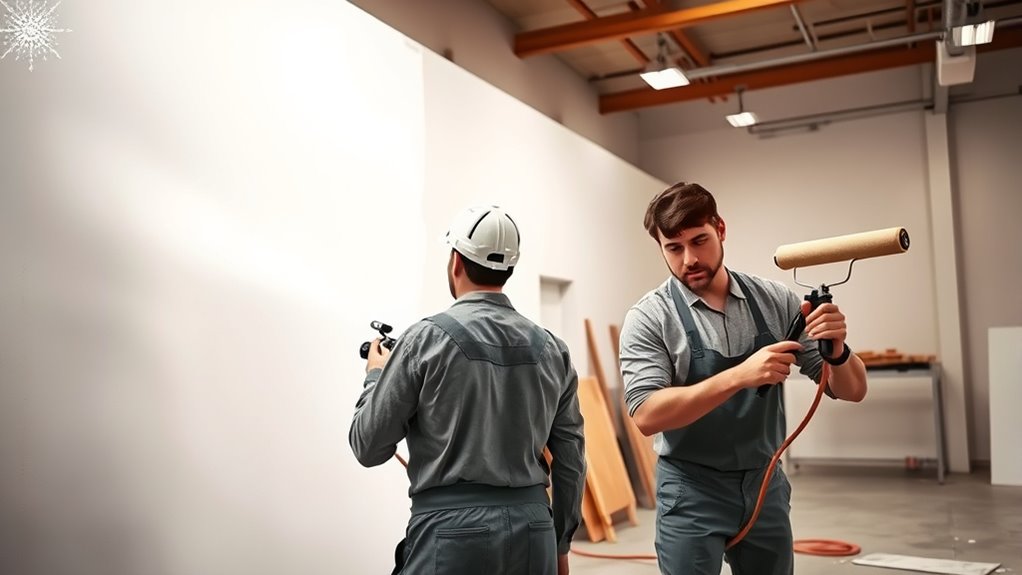
When it comes to speed and efficiency, paint sprayers often outperform rollers and brushes by covering large surfaces quickly and evenly. With spray equipment, you can skip time-consuming brush techniques and avoid the uneven streaks sometimes left by brushes. Rollers, depending on their textures, can speed up the process on textured or rough surfaces, but they still take longer than sprayers for big areas. Spray systems deliver a smooth, uniform coat in fewer passes, saving you effort and time. While brushes and rollers require more manual work and multiple coats for consistent coverage, a paint sprayer streamlines the task, making it ideal for large projects where efficiency is a priority. Additionally, choosing the right tip size ensures optimal spray pattern and finish quality, further enhancing project speed. Modern technology in spray systems can also help reduce overspray and material waste, increasing overall efficiency. Utilizing proper technique and adjusting pressure settings appropriately can also significantly improve application speed and quality. Being aware of project size helps determine the most suitable application method for your needs. Incorporating advanced features like variable flow controls can further optimize the spraying process, making your work faster and more precise.
Surface Finish and Quality of Results

When it comes to surface finish, you’ll notice differences in smoothness and texture depending on your tools. Color uniformity and consistency are also key factors that influence the final look of your project. Plus, achieving sharp edges and detailed work can vary considerably between sprayers, rollers, and brushes. Understanding the techniques used in ethical hacking can help ensure you get a more flawless result by properly preparing and utilizing your tools. Additionally, mastering body awareness techniques from somatic therapy can improve your precision and control during detailed painting tasks. Developing proper posture and movement can also minimize fatigue and enhance your overall painting accuracy.
Surface Smoothness and Texture
The choice between a paint sprayer and a roller or brush considerably impacts the surface smoothness and overall finish. A sprayer generally provides a more uniform, sleek surface with minimal textural variation, especially on large or complex areas. It helps create a smooth, consistent coat by reducing brush or roller marks. However, if not applied carefully, a sprayer can result in uneven surface adhesion or overspray, affecting the final texture. Rollers tend to leave slight textural variation, which can add character but may require additional sanding for a perfectly smooth surface. Brushes often produce more pronounced textures, making them ideal for detailed work or a rustic look. Your choice influences the surface’s tactile feel and visual quality, depending on the desired finish. Additionally, AI-driven data analytics can assist in selecting the optimal application method based on surface type and project requirements. Moreover, understanding the local regulations and resources can help you choose the most efficient and compliant application techniques for your project. Incorporating knowledge of surface preparation can further enhance the final result by ensuring proper adhesion and a smoother finish.
Color Uniformity and Consistency
A paint sprayer often delivers superior color uniformity and consistency, making it ideal for achieving a smooth, even finish across large surfaces. Its ability to maintain consistent paint flow ensures better paint consistency and more accurate color application. To maximize results, consider these factors:
- Precise control over spray settings enhances paint consistency and prevents uneven patches.
- Proper technique ensures even coverage, improving color accuracy.
- Reduced overspray minimizes waste and maintains a uniform surface.
- Consistent pressure and distance from the surface help achieve a seamless, professional finish.
Edge and Detail Precision
Edge and detail precision substantially impact the overall surface finish, especially when working on intricate areas or sharp boundaries. Achieving clean edge detail requires control to prevent paint from bleeding or overspreading. Paint sprayers excel at covering large surfaces quickly but often struggle with fine precision along edges, risking uneven lines or drips. In contrast, rollers and brushes provide better control for fine precision, allowing you to carefully define edges and detailed surfaces. If your project involves detailed trim, sharp corners, or intricate patterns, tools that prioritize edge detail will give you a cleaner, more professional look. Ultimately, the best choice depends on your need for precision versus efficiency, but for sharp boundaries and fine detail, manual tools often deliver superior surface quality. Automation technologies are increasingly used to enhance efficiency and precision in various tasks, including painting projects. Additionally, incorporating digital tools can help plan and execute detailed work more accurately, especially when combined with advanced painting equipment that improves control and consistency. As technology advances, smart painting systems are also emerging to further refine precision and streamline the painting process. Moreover, understanding the importance of surface finish and quality of results can guide you in selecting the most suitable painting method for your specific needs.
Ease of Use and Accessibility

When it comes to ease of use, a paint sprayer can save you time with faster application, but it might require more setup. Rollers and brushes are simpler to get started with and clean up quickly, especially for beginners. Consider your experience level and project needs to choose the most accessible option for you. Additionally, best paint tools can make the process even more straightforward and efficient.
Speed and Simplicity
While both paint sprayers and rollers or brushes aim to make your painting project easier, sprayers typically offer faster coverage with less effort, especially on large surfaces. This means you can complete your project more quickly, thanks to improved equipment efficiency. Using a sprayer, you’ll notice:
- Quicker painting speed, reducing overall project time
- Less physical effort compared to manual techniques
- Even application over complex or textured surfaces
- Minimal strokes, achieving a smooth finish efficiently
A jet boat utilizes high-performance engines and streamlined hulls to maximize speed and maneuverability, making it an excellent analogy for understanding how sprayers can efficiently cover large areas with less effort. Additionally, equipment efficiency plays a crucial role in delivering rapid results and reducing fatigue during extended projects. Incorporating advanced paint application techniques can further enhance your results and streamline the overall process. Improving technique mastery can optimize the use of your equipment and lead to better finishes.
Furthermore, proper priming ensures a more uniform coat and reduces the need for multiple passes, saving time and effort.
Setup and Cleanup Time
Sprayers can considerably speed up your painting process, but they often require more time upfront for setup and after for cleanup compared to rollers or brushes. You’ll need to prepare the sprayer, which includes filling it, adjusting settings, and ensuring proper primer application. During setup, you’ll also need to protect surrounding areas with drop cloths and masking tape. After painting, cleanup involves disassembling parts, cleaning the nozzle, and thoroughly washing paint from the equipment. If you’re working with multiple colors, paint mixing can add to the initial setup time. Overall, while sprayers save time during actual painting, the extra effort for setup and cleanup can be significant, making it a trade-off depending on your project size and urgency. Proper maintenance and thorough cleaning are essential to keep the sprayer functioning efficiently and to prevent clogs or damage, which is especially important given the Refrigeration Cycle principles that emphasize system upkeep for optimal performance. Including proper cleaning techniques can extend the lifespan of your equipment and ensure consistent application quality. Additionally, regularly inspecting parts helps prevent clogs or malfunction, ensuring a smoother workflow.
Accessibility for Beginners
For beginners, rollers and brushes are generally easier to learn and use confidently than sprayers. They require less setup and fewer skills to achieve good results. When starting out, you can focus on mastering basic brush techniques and roller patterns without worrying about overspray or uneven coverage. Here are some points to consider:
- Brush techniques are straightforward, allowing for precise control in tight spots.
- Roller patterns help achieve smooth, consistent coverage with minimal effort.
- No complex equipment is needed, making cleanup simple.
- Learning curve is shorter, so you can start painting confidently faster.
Cost Considerations and Budgeting
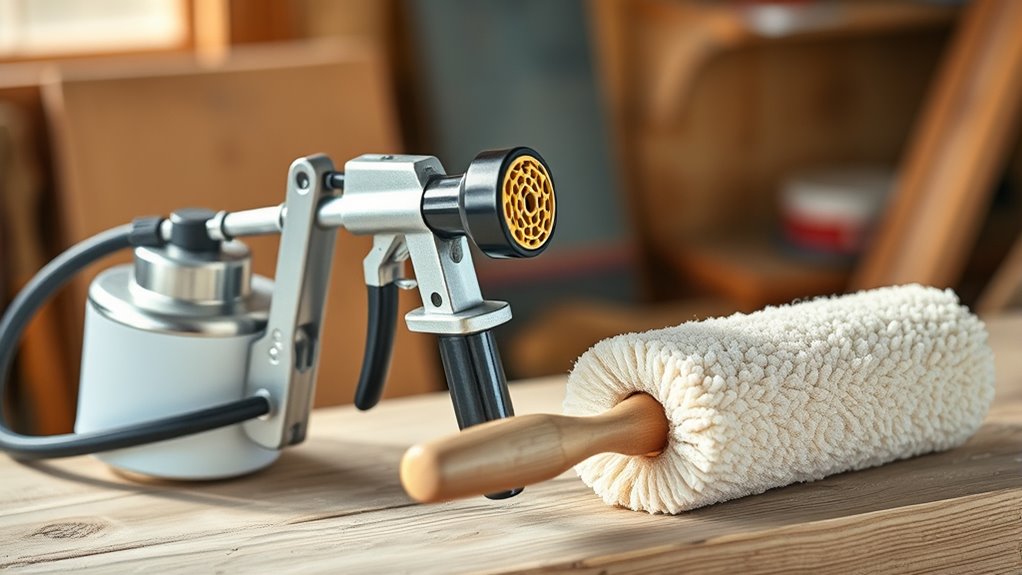
Choosing between a paint sprayer and a roller or brush often comes down to your budget and overall costs. If you have strict budget constraints, a roller or brush usually costs less upfront, with lower material costs and minimal equipment expenses. Paint sprayers tend to have higher initial costs, especially for quality models, and require additional accessories like filters and hoses, increasing your material costs. Keep in mind that while sprayers can save time, the extra investment might not be justifiable if you’re working on a small project. Conversely, for larger jobs, a sprayer could offer better value by reducing labor time, but you’ll need to weigh this against your initial spending and ongoing material expenses. Budgeting carefully helps you choose the most cost-effective option.
Suitability for Different Types of Surfaces

When selecting a painting method, consider how well it works on different surfaces. Surface adhesion and porosity are key factors influencing your choice. A paint sprayer provides a smooth, even coat on large, flat surfaces like walls and ceilings, especially where surface porosity is high, ensuring good adhesion. Rollers excel on textured or rough surfaces, as they can reach into crevices and uneven areas. Brushes are ideal for detailed work or small surfaces, offering precise control over surface adhesion.
- Paint sprayers suit smooth, non-porous surfaces for quick coverage.
- Rollers work best on textured, porous surfaces needing thorough coverage.
- Brushes are perfect for intricate or delicate surfaces.
- Consider surface porosity to optimize adhesion and finish quality.
Clean-up and Maintenance Requirements
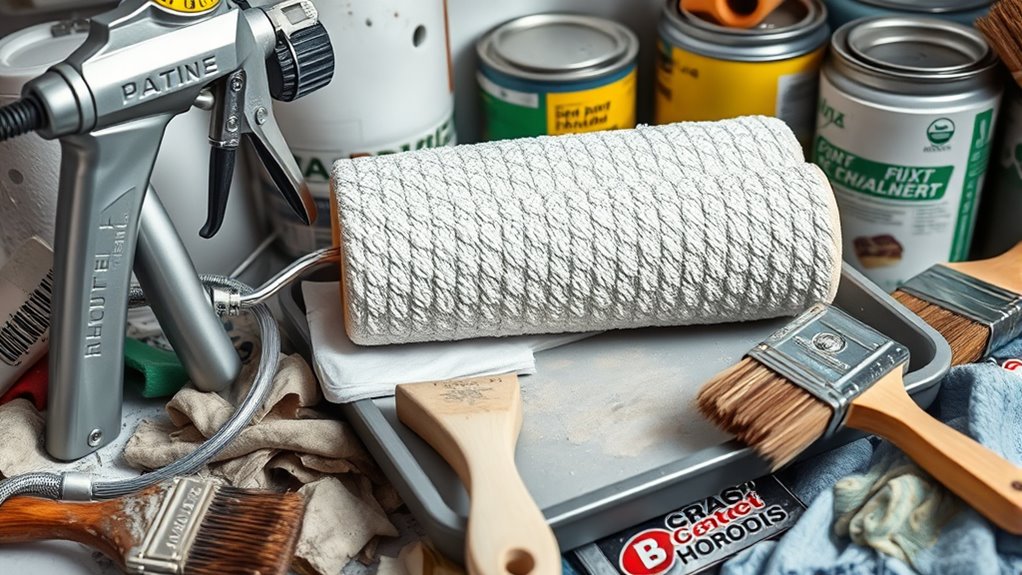
Cleaning and maintaining your painting tools is essential to guarantee their longevity and ideal performance. After painting, clean brushes thoroughly to preserve their shape and prevent brush strokes from becoming uneven. For brushes, rinse with warm water or solvent, depending on the paint type, and reshape the bristles. When using a roller or sprayer, clean tools promptly to remove excess paint, which can clog mechanisms or degrade materials over time. Proper paint mixing before application assures smooth coverage, but it also means thorough cleaning afterward to avoid dried paint buildup. Regular maintenance involves inspecting tools for damage, replacing worn parts, and storing them properly in a dry, clean place. This not only prolongs their lifespan but also ensures consistent, high-quality results on every project.
Environmental Impact and Overspray Control

Environmental impact and overspray control are essential considerations when selecting between a paint sprayer and traditional tools like rollers and brushes. Paint sprayers can produce more air pollution due to fine mist emissions, but with proper overspray control, these effects can be minimized. To reduce environmental impact, consider these factors:
Choosing proper overspray control minimizes environmental impact when using paint sprayers.
- Use environmentally friendly, low-VOC paints to lower air pollution.
- Implement overspray control techniques, such as masking and containment.
- Opt for high-efficiency sprayers with adjustable settings to limit unnecessary spray.
- Properly dispose of unused paint and clean-up materials to prevent environmental contamination.
Ideal Projects for Each Painting Method
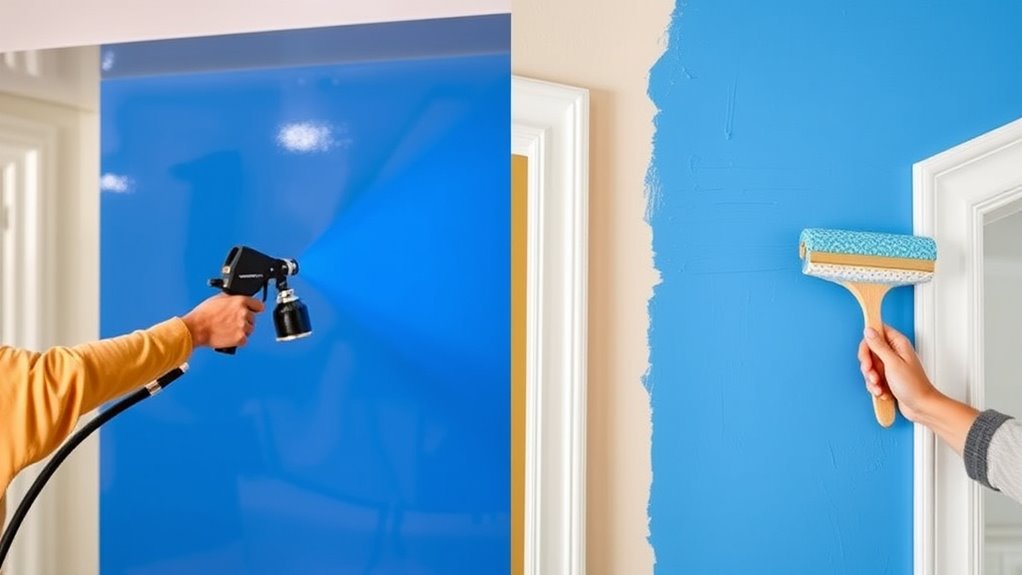
Choosing the right painting method depends largely on the scope and nature of your project. For textured walls, a paint sprayer works best, covering uneven surfaces quickly and evenly. Use rollers or brushes for furniture painting, especially for detailed or delicate pieces, to ensure precision. Consider a roller for large, flat surfaces where speed matters, and a brush for trim or intricate details. For furniture, a brush provides control, while sprayers are ideal for quick coats on large pieces.
| Project Type | Recommended Method |
|---|---|
| Textured walls | Paint sprayer |
| Large flat surfaces | Roller |
| Furniture painting | Brush or sprayer |
| Detailed trim or accents | Brush |
Frequently Asked Questions
Which Painting Method Offers Better Precision for Detailed Work?
For detailed work, you’ll find that a brush offers better precision because it allows for fine control and sharp brush detail. While spray accuracy can cover large areas quickly, it’s harder to achieve intricate lines and delicate edges with a spray. You should choose a brush when you need precision and detailed control, especially for small or complex projects, ensuring your work looks clean and professional.
How Do Weather Conditions Affect Spray Painting Versus Brushing or Rolling?
Oh, the irony of weather impact on painting—rain and wind seem to love sabotaging your efforts! When you spray paint, high humidity or wind can ruin surface adhesion and cause drips, making your job messier. Brushing or rolling might handle weather slightly better, but they still struggle with dampness. So, no matter your method, you’ll want to check the forecast and choose a day with ideal weather for a flawless finish.
Are There Safety Concerns Associated With Using Spray Paint Equipment?
When using spray paint equipment, you should be aware of safety concerns like hazardous fumes that can harm your health. Always wear proper safety gear, including masks and goggles, to protect yourself from inhaling fumes or getting paint in your eyes. Confirm good ventilation and follow manufacturer instructions carefully. Taking these precautions helps prevent accidents and keeps you safe while achieving a professional finish.
Can Both Methods Be Used on Textured or Uneven Surfaces Effectively?
You can use both methods on textured or uneven surfaces, but texture suitability varies. A paint sprayer often provides smoother, even coverage on complex textures, while rollers and brushes may struggle with deep grooves. To achieve the best results, guarantee proper surface preparation—cleaning and priming—regardless of your choice. This helps the paint adhere well and reduces issues, making each method more effective on textured or uneven surfaces.
Which Method Produces Less Odor and Airborne Fumes During Application?
Imagine you’re painting indoors and want to breathe easy. You’ll find that brushes and rollers produce considerably less airborne fumes and odor emissions compared to paint sprayers, which can disperse fumes into the air quickly. Sprayers tend to emit more odors and airborne fumes, making them less ideal for enclosed spaces. If minimizing odors is your priority, choosing brushes or rollers keeps your air cleaner and your environment safer.
Conclusion
So, whether you fancy a quick spray and a professional finish or prefer the charming chaos of brushes and rollers, remember—painting is just an excuse to get a little messy. Choose your weapon wisely, and don’t forget to blame the drips on the roller. After all, in the end, it’s not about perfection but about surviving the cleanup. Happy painting—may your walls be flawless, and your patience infinite!
Franz came aboard the Paint Sprayer Zone team with a background in both journalism and home renovation. His articulate writing style, combined with a passion for DIY projects, makes him an invaluable asset. Franz has a knack for breaking down technical jargon into easy-to-understand content, ensuring that even the most novice of readers can grasp the complexities of paint sprayers.
